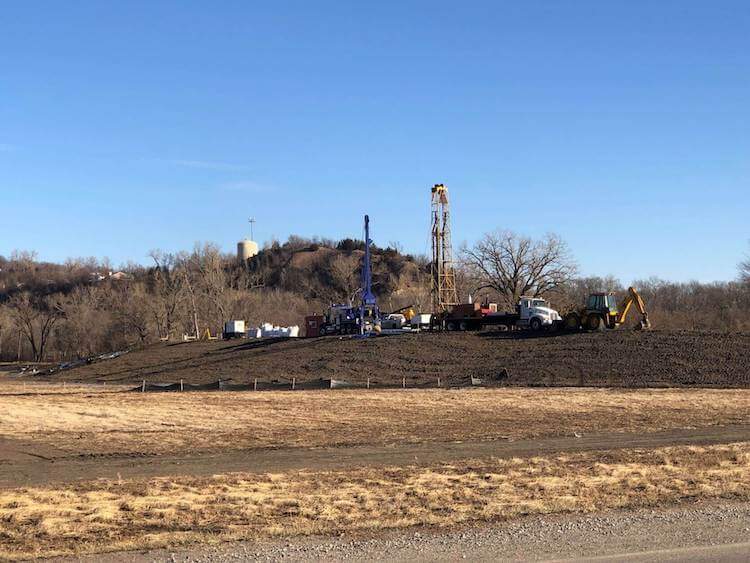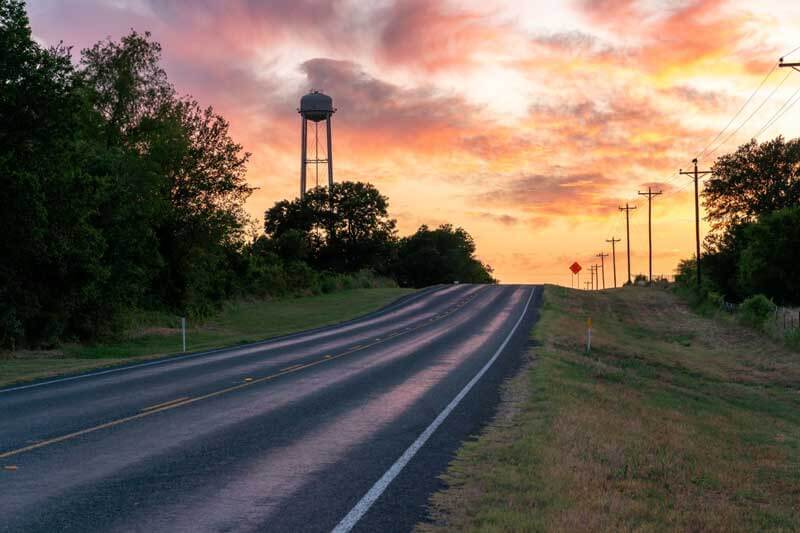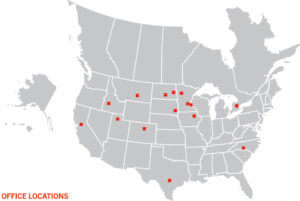Ulteig Helps Small Town in Iowa Struck by Devastating Floods Build Back its Water Supply

March 14, 2022
Hamburg, Iowa — Where the East and West Nishnabotna Rivers meet and connect to the Missouri River lies Hamburg, Iowa, a town (population 1,214) that has fought flooding since its very beginnings, going back to the 1850s. While sources of beauty and industry for the town, these two rivers placed the town directly in the epicenter of record-setting floods that devastated the Midwest during the Spring of 2019.
Record rainfalls combined with warmer than expected temperatures, which created a rapid thaw in the Northern Plains, drove the Missouri River and many of its tributaries over their banks, flooding farmlands and small towns in multiple states. When a temporary levee, constructed after a previous flood, broke, the majority of Hamburg and the neighboring area was submerged.
In the center of Hamburg stands a flagpole by which all previous floods have been measured. During the 2019 flood, water rose to 4 feet on the flagpole – the highest ever in the town’s history. The extensive damage impacted, and in some cases destroyed, more than 50% of the town’s commercial and industrial buildings, devastating 77 family homes, and displacing at least 250 residents. This quiet, sleepy farm town became the poster child of the Great Flood of 2019 with video images making international headlines.
“Many of those homes had more than three people living in them. During and after the flood, I know of one home that had seven different families living in it because that’s the only place they had to go. So truthfully, the flood displaced several hundred people,” said Rick Allely, CEcD, MCRP, Market Development Manager of Transportation at Ulteig and a key leader on the team taking on Hamburg’s restoration.
Chosen for our unmatched expertise in renovating water and transportation infrastructure across the nation, Ulteig’s Transportation and Civil Engineering experts helped lead the task of replacing Hamburg’s municipal wells as a direct result of the 2019 Missouri River flooding.
Bouncing Back from Tragedy
For small towns across North America, water is life. Without access to clean water and a reliable system to dispose of wastewater, there’s little chance a town will grow.
When the Great Floods of 2019 overwhelmed Hamburg, the town’s future was also put in jeopardy. Hamburg’s fast-acting public works team attempted to save the municipality’s two wells by reinforcing berms around them. Members of the community sandbagged the water plant, and a back-up well was drilled on the north side of town to provide water for fire protection and use of sanitary bathrooms. Both existing wells were severely impacted, and the damage was done. One well was not able to be recovered from the submergence, and the other was brought back to only 2/3 capacity. No drinking water was produced for several months immediately following the flood, and the townspeople have been relying on just one well, operating at two-thirds capacity ever since.
With just one operating well, Hamburg’s leaders knew that they needed to rethink their water situation and prepare for another potential flood or other extreme weather events, all while simultaneously bouncing back from the tragedy at hand.
“Everybody knows you need a strong and reliable water system to survive, let alone grow as a town,” said Allely. “This is a community that was devastated in every which way, but the people are coming back stronger and better than they were before. Ulteig is helping them achieve their goals of resiliency and growth.”
Re-building Hamburg in a Pandemic
Due to the magnitude of the flood damage in combination with other factors, many challenges arose during the undertaking of the Hamburg water project.
One of the most pressing challenges was the need to provide residents and businesses with access to clean drinking water despite both wells being fully submerged by the 2019 floodwaters and the damage to the water treatment facility caused by the elevated floodwaters.
The issue was only made worse by a 9-month long drought. The town, which had previously been devastated by a sheer quantity of water, was now praying for rainfall during the Summer of 2021.
“At the worst time possible, the city got hit with one of the most severe droughts we’ve seen in Southwest Iowa in some time. They had to ration water,” said Allely.
“There was fear that they wouldn’t be able to supply enough water for residents and industries in the area,” added Charlie Bechtold, a Senior Engineer with Ulteig.
Time was of the essence, but conflicting guidelines from different government agencies, a multitude of archaeological site investigations in the area, and COVID-19-driven supply chain issues made it incredibly difficult for the team to begin implementing designs quickly. At the last minute, an unexpected additional archeological site investigation delayed the project by six months, pushing the project’s construction right into the throws of the emergence of the COVID-19 pandemic.
“The difference between material pricing and availability of contractors from December 2020 to May 2021 was night and day,” said Allely. “By that time, COVID-19 was impacting pricing and availability to a dramatic extent, causing the bids to be 40% higher than what they had previously been estimated to be.”
“The pandemic-driven supply chain issue was a large obstacle,” added Brian Hiles, a Senior Engineer with Ulteig. “Certain materials were no longer readily available, so we had to re-design the project that May. To accommodate for material availability and new pricing while staying on our time schedule, we completed a full redesign of the project to adapt to the new conditions, so that we could use materials that were more readily available and less expensive for the town.
Hamburg City Clerk Sheryl Owens, who has collaborated with Ulteig from the beginning of the project, reflected on challenges faced and the importance of collaboration. “Despite facing many hurdles, including contractor availability, we have been patient and appreciative of all the work each party has completed.”
Combining Forces to Build a More Resilient System
Ulteig worked in collaboration with the U.S. Army Corps of Engineers, the Federal Emergency Management Agency (FEMA), USDA-RD and multiple state agencies to implement a complete solution for the town that will make the town’s water infrastructure stronger and more resilient to future flooding events.
Anticipating future flooding, the following changes were recommended and implemented:
- Replace the town’s one remaining well with two new wells designed in anticipation of future 100-year flooding events.
To mitigate future flooding, the two new wells were built at a height of 0.5 feet above the elevation of a new, permanent levee built by the U.S. Army Corps of Engineers. The floor of the building that houses the new wells is six inches above the elevation of the dikes.
- Permanently replace the levee (or dike) along the western side of town. The levee that was breached during the Great Flood of 2019 was built to be temporary (built back in 2011). In the reconstruction, the new levee was now built to withstand a 500-year flood event.
- Implement a permanent propane generator to power the site and operate the wells if power were to ever go out to ensure residents have access to water.
In meeting with Hamburg’s residents to brief them about the plan, Ulteig engineers noted the determination of Hamburg residents to do it “right.” After a town experiences the devastation that Hamburg did, you would think that folks would want to pick up and leave. But not in Hamburg. Members of the community voiced their passion for their hometown and their determination to build it back stronger than before.
Looking ahead to the completion of the project in Spring of 2022, Owens mentioned, “The citizens are excited to see the project underway and look to a better future.”
Alley added, “The amazing thing is, most people would just pick up and say, all right, I’m out of here. I’m moving to the next city – or I’m moving two states away. That did not happen here. The people were dedicated to the community that they had built, and they wanted to come back.”
Building on the town’s determination, the team envisioned a design that would build a strong foundation for generations to come.
“I had been working very closely with leadership in Hamburg before the beginning of the project, so I was already acquainted with the infrastructural, economic and social needs of the community,” said Allely. “I actually grew up with Alan Dovel, Hamburg’s Public Works Director. When I went to work for Ulteig on that Monday, June 1, 2019, Hamburg was my first call. I went down to Hamburg and I said, ‘Al, I have your back. I know the company that can help you out.’ And we started discussions right then and there.”
Indeed, the engineers noted that, besides having the technical expertise to execute their future-forward plan for the town, the key to the success of this project was frequent and direct communication with all agencies and city representatives involved. “Nothing about this process was top-down; the townspeople were intimately involved from the very beginning,” added Hiles.
“My overall perspective on the project was that it was a community effort,” said Bechtold. “My colleague Brian Hiles held monthly progress meetings open to the public involving residents, city officials and staff, along with multiple government entities. Our team was able to establish fluid communication between everyone involved.”
“We would never enter a project saying, ‘It’s our way or no way,’” added Hiles. “It was important for us to continually check in and ensure that we were meeting the needs of the town with our efforts and that everybody was on the same page.”
Solidifying a Future for Your Town
“I entered into civil engineering so I could help people. That was always the goal,” said Hiles. “It is extremely fulfilling to know that there are thousands of people out there that are relying on the experience and innovation that Ulteig provides.”
In addition to being proud of helping the town of Hamburg, the project also served up a dose of reality to all those involved.
“It’s not a matter of if a disaster like the flooding that Hamburg experienced happens, but when it happens,” said Allely. “This is my advice for any public works director reading this story – don’t wait. Take the time now to understand the condition of your town’s infrastructure and establish a plan so that your town is prepared. It could be a flooding event. It could be any type of natural or manmade disaster.”
Hamburg Public Works Director Al Dovel noted, “We are very appreciative of Ulteig, USDA-RD, SWIPCO, and the various state agencies who have felt the frustrations of project constraints impacting the timeline and costs of the project. Our citizens and businesses are ready for these wells to become operable so we can tackle the next project.”
Learn More About Ulteig’s Customizable Solutions
Go to Ulteig’s Transportation page for more information about their Transportation expertise. To view more stories like Hamburg’s, visit our Knowledge Center.
WHAT MAKES ULTEIG DIFFERENT?
From global energy producers to locally funded cities and private developers to government agencies, the clients we serve encompass a broad range of relationships and projects. Find out why Ulteig is a leader in the engineering industry.
Contact Us


